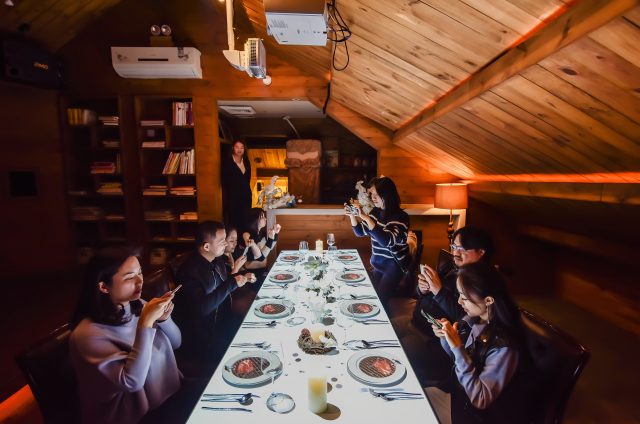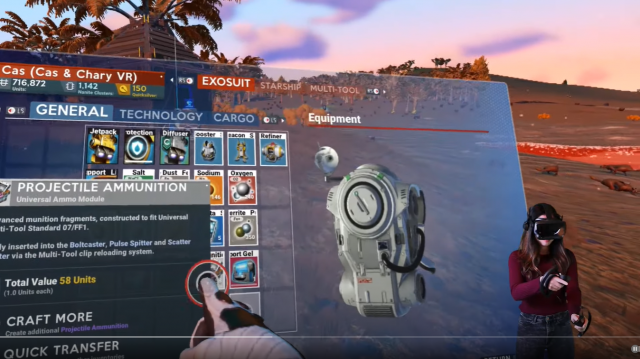A screenshot of the street view of the virtual city in Richie’s Plank
Introduction
Richie’s Plank Experience is a VR experience that clones the real-life environment of walking on a single plank from an elevator on the 80th floor of a skyscraper. First released in 2016, it became widely popular for its realistic graphics and heartstopping experience for users. Beyond the psychological experience, it also offers 4 bonus modes:
- Fire Deck – Users get to fly around the virtual city like a superhero with the controllers to fly around the virtual city and extinguish fires with a fire hose and rocket hands.
- Sky Brush – Users can write and draw the sky in different colors using rocket hands as a paintbrush.
- Nightmare Mode – By pressing 666 on the panel on the left, users will experience the plank with spooky additions.
- Santa Simulator – Reindeer will pick the user up in Santa’s sleigh such that users can deliver presents into chimneys.
Video gameplay of all modes of Richie’s Plank Experience
Why they are engaging?
From seeing many gameplay videos of Richie’s Plank, many users seem to be very immersed and engaged in the experience that the application offers as they react realistically. As Slater (2009) put together, there are 2 orthogonal components that contribute to users being engaged realistically in VR: place illusion (PI) or presence, and plausibility illusion (Psi). I believe that Richie’s Plank has very effectively fulfilled the two criteria, and therefore can engage audiences very well.
Richie’s Plank Experience Trailer
Firstly, it is able to provide the illusion of presence, specifically the illusion of being in a stable spacial place and physical interaction. This is done through the hyperrealistic portrayal of the urban city landscape with moving vehicles and tall buildings. Coupled with the dynamic lighting and effective usage of perceptive illusion to depict spacial distances make the environment look realistic (See 0:02 to 0:10 of video). This is further amplified by how players are able to manipulate some parts of the virtual environment in a way that mirrors the physical environment.
Secondly, it is able to trick users to believe that what is in front of them is really happening even though they know it is not real, which is a plausibility illusion (Psi). In order to achieve that, there have to be “correlations between external events not directly caused by the participant and his/her own sensations (both exteroceptive and interoceptive)” (Slater, 2009). How Richie’s Plank does this is by involving multiple sensory receptors to provide understanding to the players such as using elevator music in the lift and also having the ambient sound of wind and birds while on the 80th storey.
Why do you like this XR application?
I like this XR application as it is very unique in how it has relatively simple mechanics and functions, it is able to become very engaging, so much so that when users engage with the application, they show similar reactions as if the things they are seeing in the VR application is happening for real. I am very amazed by how this is initially developed by a team of husband and wife before expanding to form a full team.
I also like how there are different modes to the experience, which are all very creative ideas that use the landscape and do things that are not possible for humans to do. For instance, with Fire Deck mode, users can fly around with rocket hands and put out fires, which is definitely not possible under the laws of physics. Sky Brush also allows artistic individuals to enjoy the VR experience and fulfilling probably many children’s dreams of being able to paint the sky. These fun touches make the application more interesting. Notably, I did not see anyone complain about vertigo or other ‘VR illness’, despite allowing users to fly around.
What features are well done?
The modeling of the virtual city environment is definitely a very well-done feature of the application. A lot of work is placed into making sure that the look and feel of the city landscape are as realistic and beautiful as possible such that they can provide users with the best experience. This is also why this experience is so well-known for being able to engage its audience and evoke realistic reactions. The picture below shows how the view from the plank changed as the application got developed – from the early access version to the final version that is on the market today.
View from the plank changed from the early access version to the final version
It is also very interesting how the developers of the application encouraged the audience to use a real plank – making use of an additional sense of touch – to make the experience more ‘authentic’. It brings this VR experience somewhat closer to Hyper-VR, where the virtual plank now feels like an actual plank below one’s feet.
What features can be improved and how?
I think that Richie’s Plank can further enhance the illusion of presence to users through the usage of giving users a false sense of embodiment of a body. It is quite a waste that there is no feet tracking that is working well for this game. When the audience can see their feet while walking on the plank, they will have a stronger sense that they are physically there in the VR. Although there have been attempts at trying to attach sensors onto feet so that when the player looks down, it is not fully integrated. Though expensive, there are now shoe accessories specially made for VR so that feet movement can be tracked naturally. One such example is the Cybershoes, as seen in the picture below.
Old sensor-attached shoes
Cybershoes
Furthermore, the player, when interacting, sees the joystick instead of some form of a hand to indicate that they are currently a form of character instead of a pair of floating joysticks. There was feasibility testing done for hand tracking on Occulus but unfortunately there has been no update from the developers since 3 years ago. Actually, the developers don’t have to achieve extremely accurate hand movement. There are only a few actions that are performed by the hand, and therefore simply having an iconic representation of a hand would be a great start to better representational fidelity in my opinion.

Picture of Feasibility test for hand-tracking in Richie’s Plank
Last but not least, I think that this application last replayability. While the developers have highlighted that this is not a game but an experience, I feel like there are a lot of things one can do with the premise set up with such nicely done models. For instance, players can be given the opportunity to explore the city and perhaps even have the power to customize the city. In the future, it can even grow to be like Minecraft but in VR.
Conclusion
In conclusion, Richie’s Plank Experience is a good example of a VR experience and suitable for entry into VR with its simple mechanics and realistic modeling. While it is not perfect, it is certainly very engaging to the audience.
While researching the XR application, it is noteworthy that Richie’s Plank Experience is not only played for fun but used in research. Surprisingly, it is not only VR research that uses the application. It is also used for investigation into acrophobia (fear of heights) (Hu, 2018) and mental dissociation (Caulfield, 2022). Therefore, it is an interesting angle to look into how VR can help to further research into human behavior sciences and mental health as it is able to offer experiences that will trigger realistic physical and bodily reactions with less harm (as it is not actually happening to the participants) and less cost (as physical venue and activity constraints are now not a problem).
References
- Caulfield, N. M., Karnick, A. T., & Capron, D. W. (2022). Exploring dissociation as a facilitator of suicide risk: A translational investigation using virtual reality. Journal of affective disorders, 297, 517-524.
- Cybershoes US – Shoes made for walking in VR. (n.d.). Retrieved January 19, 2023, from https://www.cybershoes.com/
- Hu, F., Wang, H., Chen, J., & Gong, J. (2018, August). Research on the characteristics of acrophobia in virtual altitude environment. In 2018 IEEE International Conference on Intelligence and Safety for Robotics (ISR) (pp. 238-243). IEEE.
- Reddit – Dive into anything. (n.d.). Retrieved January 19, 2023, from https://www.reddit.com/r/SteamVR/comments/7jbp3a/special_announcement_richies_plank_experience/
- Richie’s Plank Experience on Steam. (n.d.). Retrieved January 19, 2023, from https://store.steampowered.com/app/517160/Richies_Plank_Experience/ Slater, M. (2009). Place illusion and plausibility can lead to realistic behaviour in immersive virtual environments. Philosophical Transactions of the Royal Society B: Biological Sciences, 364(1535), 3549-3557.
- Todorov, D. (n.d.). Richie’s Plank Experience. Retrieved January 19, 2023, from https://dannytodo.artstation.com/projects/xzxqD2








